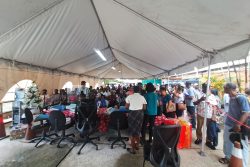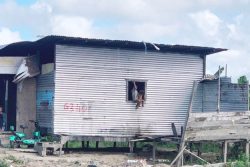It is now a year and more since millions of children across the world, including here in Guyana, have had no access to formal education, that is, the transfer of knowledge that derives from face to face communication and which includes the simultaneous sharing of information in a real time, interactive, learning-friendly environment. Large numbers have also not benefitted from transfer of knowledge in any way, shape or form, over the same period.
Mind you, it is not that we are unmindful of the ‘saving grace’ that virtual education delivery has afforded in allowing for the application of an option. The absence, however, of the attributes that make the conventional classroom what it is, cannot be denied. Down the road, a great deal of both time and material and intellectual resources are going to have to be expended in putting our conventional education system back together again, never mind the ‘gaff’ about Covid-19 having sealed the fate of actual classroom tuition. Down the road there is going to be a price to be paid for the fracture of the classroom teaching/ learning regime.
What we are likely to find, too, once the rebuilding begins, is not just that it cannot be rushed but that, for countries like Guyana, particularly, where the education systems entered the Covid-19 maze in an already seriously fractured state, in the first place, recovery will take longer. As a consequence, both the pace and trajectory of our development could be seriously impacted during the interregnum.
Understandably, the current preoccupation is with seeking to ensure that we not be confronted with an across-the-board, complete collapse of the entire teaching/learning regime. The problem here reposes in our inability to predict the behaviour of the pandemic, going forward. What now appears to be its impactful ‘mood swings’ and how those interface with our own behaviour has become a huge headache. The ebb and flow of the virus Covid-19 appears linked to our behaviour as its target victims. The problem here is that, on a global scale, it is we and not the pandemic, who are on the defensive, retreating into increasingly defensive positions, not least, increasingly restrictive curfews, the advent of a range of vaccinations notwithstanding.
There has developed, too, over time, a growing body of opinion to the effect that we are ‘our own worst enemy’ insofar as the spread of the pandemic is concerned. We have, it is felt, been painfully slow in making changes to the levels of our discipline. If that is so, it has to change quickly; it is either that or we face the reality of having to face a long, dark night…at least so it seems.
Poor countries like Guyana have their own challenges here. These are mostly linked to the fact that ‘holding the line’ against the pandemic itself leaves little of our already limited material or intellectual resources for the fashioning of an education system that can at least serve a coping function. Even stop-gap remedies cannot be relied upon if we do not (and we don’t) understand the erratic behaviour of the virus.
The problem does not end there. If we isolate the phenomenon of the nexus between school being ‘out’ for a year and more and the ‘free- time’ that this affords thousands of pre-teen and teen-aged children across coastal and hinterland Guyana, the magnitude of the problem stands out more starkly. Amongst many of them there may well have occurred a loss of interest in formal schooling. In coastal communities, particularly, we are bound to find that not all of the cycle-riding groups of pre-teen and teen-aged groups of (mostly) young males do so for recreational purposes. In less well-off homes schools’ ‘down time’ has created opportunity for short-term ‘hold-ons’ (temporary jobs) that have, in many cases, metamorphosed into longer-term child labour. Here is an example of an instance in which the absence of the formal school system may have come to be seen by both poor families and exploitative employers as a virtue in its own right.
The available evidence suggests that rich countries, far less poor ones, were hopelessly unprepared for the onslaught of the pandemic and the consequential sudden loss of the conventional school system. What we have begun to discover, as well, is that the problem goes beyond that. Sooner rather than later we are bound to come face to face with the overall developmental deficit that almost certainly lies ahead.
Insofar as education delivery is concerned we must, of course accept the ‘saving grace’ of information technology coupled with the robust response of our teaching professionals. Who can, however, deny that a system that turns on affordability for the ‘takers’ and one, moreover, that cannot be applied in the absence of a costly state-financed infrastructure can possibly replace – at least in the short to medium term – a system that has been tried and tested and has thrived on a track record of a certain level of success despite what we know to be its inherent weaknesses. Here there is one virtue that cannot be overlooked. What, insofar as the development, globally, of education systems in poor countries has done, is to shine a spotlight on the importance of creating sturdier linkages between actual and virtual education, which linkages are likely to provide a stronger, more resilient education system.
How to reconnect many children with the conventional teaching/learning system once we outlast the pandemic will, be one of our bigger challenges. To assume that it will amount to little more than putting classrooms together, mobilizing teachers and suitably equipping children to physically return to the classroom would be a pointless fallacy. What the Covid-19 hiatus has done, among other things, is to erect a psychological barrier between large numbers of children and formal education. A great many of them (the children) have now created ‘comfort zones’ within those spaces.
While the routine of delivering and receiving education is likely to be less challenging for children who have benefitted from being able to fall back on virtual learning for whatever period Covid-19 would have lasted, the reality is that a year and a bit (so far) out of uniform, out of classroom and out of the various other routines associated with conventional learning have impacted on thousands of children here in Guyana, not least those whose home and social environments are not blessed with the requisites, including the resources and the discipline that have allowed for a near seamless continuity in their access to formal learning. Finding their way back into that system will be a testing challenge for those children. Many will probably see no incentive to try. If these may not be pleasing realities, we stand a better chance of getting over the hurdles if we accept that they exist in the first place.





